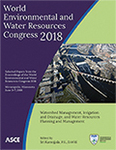World Environmental and Water Resources Congress 2018
System Archetypes in Water Resource Management
Publication: World Environmental and Water Resources Congress 2018: Watershed Management, Irrigation and Drainage, and Water Resources Planning and Management
ABSTRACT
Many water resources management (WRM) problems are similar in nature, and yet they continuously appear in different forms and in different geographical locations. Understanding a malfunctioning system structure is essential for developing sustainable solutions, which should be further examined using detailed quantitative models. Persistent WRM problems can be explained at the strategic level using a set of generic system structures, commonly known as system archetypes. These causal-descriptive conceptual models can be used as diagnostic tools to identify weak links and problematic feedback loops in management schemes, facilitating the dissemination of policy-relevant insights for addressing the weaknesses. This paper illustrates the use of generic structures in water resources systems for uncovering the root cause of some ubiquitous WRM problems and potential unintended consequences of short-sighted solutions. The utility of system archetypes is discussed in terms of gaining big-picture systemic insights, developing effective technological solutions and complementary management policies, and monitoring sustainable system trajectories.
Get full access to this chapter
View all available purchase options and get full access to this chapter.
4. REFERENCES
Ackoff, R. L. (1993). From mechanistic to social systemic thinking. Pegasus Communications, Incorporated.
AghaKouchak, A., Norouzi, H., Madani, K., Mirchi, A., Azarderakhsh, M., Nazemi, A., Nasrollahi, N., Farahmand, A., Mehran, A. and Hasanzadeh, E. (2015). Aral Sea syndrome desiccates Lake Urmia: call for action. Journal of Great Lakes Research, 41(1), pp.307–311.
Arrow, K., Bolin, B., Costanza, R., Dasgupta, P., Folke, C., Holling, C. S. (1995). Economic growth, carrying capacity, and the environment. Ecological Economics, 15(2), 91–95.
Backlund, A. (2000). The definition of system. Kybernetes, 29(4), 444–451.
Bagheri, A., and Hjorth, P. (2007). A framework for process indicators to monitor for sustainable development: practice to an urban water system. Environment, Development and Sustainability, 9(2), 143–161.
Bailey, K. D. (1994). Sociology and the new systems theory: Toward a theoretical synthesis. Suny Press.
Bishop, R. C. (1993). Economic efficiency, sustainability, and biodiversity. Ambio, 69–73.
Braun, W. (2002). The system archetypes. System, 2002, 27.
Cai, X., McKinney, D. C., and Rosegrant, M. W. (2003). Sustainability analysis for irrigation water management in the Aral Sea region. Agricultural Systems, 76(3), 1043–1066.
Forrester, J. W. (1971). World dynamics. Wright-Allen Press.
Gleick, P. H. (1998). Water in crisis: paths to sustainable water use. Ecological Applications, 8(3), 571–579.
Gohari, A., Eslamian, S., Mirchi, A., Abedi-Koupaei, J., Bavani, A. M., and Madani, K. (2013). Water transfer as a solution to water shortage: a fix that can backfire. Journal of Hydrology, 491, 23–39.
Gohari, A., Mirchi, A. and Madani, K. (2017). System Dynamics Evaluation of Climate Change Adaptation Strategies for Water Resources Management in Central Iran. Water Resources Management, 31(5), pp.1413–1434.
Haraldsson, H. V., Belyazid, S., and Sverdrup, H. U. (2006, June). Causal Loop Diagrams–promoting deep learning of complex systems in engineering education. In 4th Pedagogical Inspiration Conference (Vol. 1).
Hutchinson, C. F., Varady, R. G., and Drake, S. (2010). Old and new: Changing paradigms in arid lands water management. In Water and Sustainability in Arid Regions (pp. 311–332). Springer.
Kim, D. H. (1999). Introduction to systems thinking (Vol. 16). Pegasus Communications Waltham, MA.
Langefors, B. (1995). Essays on Infology: Summing Up and Planning for the Future, Student literature. Lund, Sweden.
Madani, K., and Mariño, M. A. (2009). System dynamics analysis for managing Iran’s Zayandeh-Rud river basin. Water Resources Management, 23(11), 2163–2187.
Meadows, D. H., Meadows, D. L., Randers, J., and William, W. Behrens, I. (1971). The Limits to Growth. London: Pan Books, Ltd.
Meadows, D. H., and Wright, D. (2008). Thinking in Systems: A Primer. Chelsea Green Publishing.
Miller, J. G. (1965). Living systems: Basic concepts. Systems Research and Behavioral Science, 10(3), 193–237.
Mirchi, A., and Watkins, D Jr. (2012). A systems approach to holistic total maximum daily load policy: case of Lake Allegan, Michigan. Journal of Water Resources Planning and Management, 139(5), 544–553.
Moxnes, E. (1998). Not only the tragedy of the commons: misperceptions of bioeconomics. Management Science, 44(9), 1234–1248.
Nørgaard, J., Ragnarsdóttir, K. V., and Peet, J. (2010). The history of the limits to growth. Solutions Journal, 1(2), 59–63.
Senge, P. (1990). The fifth discipline: The art and science of the learning organization. New York: Currency Doubleday.
Senge, P. M., and Sterman, J. D. (1992). Systems thinking and organizational learning: Acting locally and thinking globally in the organization of the future. European Journal of Operational Research, 59(1), 137–150.
UC-Irvine/NASA (National Aeronautics and Space Administration). (2015). Third of Big Groundwater Basins in Distress. < https://www.jpl.nasa.gov/news/news.php?feature=4626> Accessed 15 January 2018.
Wolstenholme, E. (2004). Using generic system archetypes to support thinking and modelling. System Dynamics Review, 20(4), 341–356.
Wolstenholme, E. F. (2003). Towards the definition and use of a core set of archetypal structures in system dynamics. System Dynamics Review, 19(1), 7–26.
Zhao, X., Liu, J., Yang, H., Duarte, R., Tillotson, M. R., and Hubacek, K. (2016). Burden shifting of water quantity and quality stress from megacity Shanghai. Water Resources Research, 52(9), 6916–6927.
Information & Authors
Information
Published In
World Environmental and Water Resources Congress 2018: Watershed Management, Irrigation and Drainage, and Water Resources Planning and Management
Pages: 130 - 140
Editor: Sri Kamojjala, Las Vegas Valley Water District
ISBN (Online): 978-0-7844-8140-0
Copyright
© 2018 American Society of Civil Engineers.
History
Published online: May 31, 2018
Authors
Metrics & Citations
Metrics
Citations
Download citation
If you have the appropriate software installed, you can download article citation data to the citation manager of your choice. Simply select your manager software from the list below and click Download.
